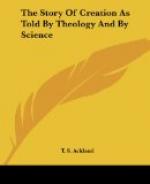One characteristic of cryptogamic vegetation is important for its bearing on the work of the fourth day. Almost all the phanerogamic plants are dependent for their development upon the direct light and heat of the sun. Deprived of these they either perish entirely, or make an unhealthy growth, and produce little or no fruit. But the cryptogamia, in general, thrive best when they are protected from the direct rays of the sun. They nourish in a diffused light, and with abundant atmospheric moisture. And so we find them at this time doing what seems a very important work in the progress of the world. By taking up and decomposing the excess of carbonic acid which at this time probably existed in the atmosphere, they at once purified that atmosphere, and rendered it fit for the respiration of more highly organized creatures, and laid up in the earth an invaluable store of fuel for the future use of man. The other orders of vegetation seem to have existed in very small proportions at this time, and only in their lower forms. As the conditions of the earth changed, the cryptogamia seemed to have dwindled away, while higher forms of vegetation asserted their supremacy. It is not, however, improbable that a special development at a much later period is indicated by the mention in the second chapter of the formation of the garden of Eden.
Section 7. The fourth day.
“And God said, Let there be luminaries in the firmament of heaven to divide between the day and the night, and let them be for signs and for seasons, and for days and for years.
“And let them be for luminaries in the firmament of heaven to give light upon the earth; and it was so.
“And God made the two luminaries, the great ones; the luminary, the great one, to rule over the day, and the luminary, the small one, to rule over the night, and also the stars.
“And God gave them in the firmament of heaven to give light upon the earth.
“And to rule over the day and over the night, and to divide between the light and between the darkness; and God saw that it was good.
“And there was evening, and there was morning, a fourth day.”
This day’s work differs from that of the preceding and succeeding days, in the fact that its sphere was without the earth, which was only indirectly influenced by it, and consequently the geological records give us no direct information upon the subject, though in two points they tally with the Mosaical account. In the first place, the deposits of coal, which preceded this period, indicate a time when a nearly uniform temperature, and that a high one, prevailed throughout the world. The coal beds are found not only in tropical regions, but in very high latitudes. Not only is the vegetation of which these coalfields are the result, analogous to that which is now found in warm climates only—(this might be the case, and yet we should not be justified in drawing




